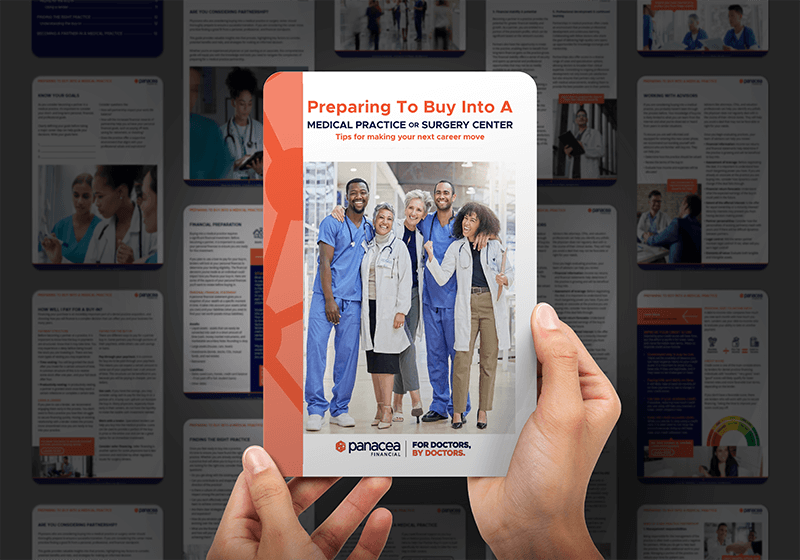Preparing to Buy Into a Medical Practice or Surgery Center

Tips for making your next career move
Keep Reading or Download the PDF ↓
minute read
Skip Ahead
Are You Considering Partnership?
Physicians who are considering buying into a medical practice or surgery center should thoroughly prepare to ensure a successful transition. If you are considering this career move, prioritize finding a good fit from a personal, professional, and financial standpoint.
This guide provides valuable insights into that process, highlighting key factors to consider, potential benefits and risks, and strategies for making an informed decision.
Whether you’re an experienced physician or just starting as an associate, this comprehensive guide will equip you with the knowledge and tools you need to navigate the complexities of preparing for a medical practice partnership.
Is Partnership Right For Me?
Becoming a partner in a medical practice can be a great career move for many physicians, but it’s not right for all. It depends on the individual physician, their needs, and the practice they are considering buying into. Let’s weigh the pros and cons.
BENEFITS OF MEDICAL PRACTICE PARTNERSHIP
1. Shared decision-making & autonomy
One of the key benefits of being a partner is the chance to engage in collective decision-making. Rather than following directives as an employee, you’ll actively contribute to guiding the practice’s direction.
Partnerships create a democratic environment where all physician-partners can influence essential decisions, including staff hiring, technology adoption, and policy setting. This collaborative approach not only enhances professional satisfaction but also ensures that the practice reflects the shared vision and values of all partners.
2. Building a reputation & patient loyalty
Becoming a partner enables physicians to enhance their reputation and foster patient loyalty, which are invaluable assets for your practice. As a partner, you can establish long-term relationships with patients, providing consistent care and personalized attention. This continuity builds trust, a key element in patient satisfaction and loyalty.
By offering exceptional care and cultivating strong patient relationships, partners can boost their professional reputation and become trusted healthcare providers within their community.
3. Financial stability & potential
Becoming a partner in a practice provides the potential for greater financial stability and growth. As a partner, you are entitled to a portion of the practice’s profits, which can be significant depending on the venture’s success.
Partners also have the opportunity to invest in the practice, enabling them to benefit from long-term financial gains as the practice grows. This financial stability offers a sense of security and opens up personal and professional opportunities that may not be as readily available to an associate physician.

4. Flexibility & work-life balance
Another significant advantage of becoming a partner in a medical practice is the potential for greater flexibility and improved work-life balance. While establishing a solo practice demands dedication and hard work, partnerships can eventually offer the freedom to create a schedule that suits your preferences.
Partners have more control over their time, enabling you to balance professional responsibilities with personal commitments. This flexibility enhances overall job satisfaction, promotes physical and emotional well-being, reduces burnout, and improves quality of life.
5. Professional development & continued learning
Partnerships in medical practices often create an environment that promotes professional development and continuous learning. Collaborating with fellow doctors who share the goal of delivering high-quality care opens up opportunities for knowledge exchange and mentorship.
Partnerships also offer access to a diverse range of cases and specialization options, allowing doctors to broaden their clinical expertise. Committing to ongoing professional development not only boosts job satisfaction but also ensures that partners stay current with medical advancements, enabling them to provide the best possible care to their patients.
RISKS OF A MEDICAL PRACTICE PARTNERSHIP
1. Management responsibilities
Being responsible for the management of the practice is often both a positive and a negative for partners. While you do get to help lead the practice, this adds additional work to your plate. Managing a portion of the practice can reduce your time for patient care.
2. Interpersonal challenges
Medical practice partnerships are long-term investments. If there are personal conflicts between partners, the working relationship could crumble. Maintaining clear expectations and prioritizing communication can help prevent these interpersonal issues.
3. Financial and legal risks
As part-owner of a practice, you are susceptible to the effects of financial and legal challenges. If your practice faces financial difficulties, you will be responsible for a portion of the financial need or debt. If malpractice claims or other legal issues arise,
you, along with your partners, will be liable.
PARTNERSHIPS AS A NEW ASSOCIATE
Many physicians become partners in the practices they are already working for, so if you are just starting as an associate but are considering becoming a partner in the practice in the future, it is recommended that you talk with your employer early on in your time there.
You don’t want to work at a practice with the hope of partnership without knowing that it could be a possibility if the fit is right. Additionally, there is often a 2-3 year waiting period before you will be considered for a buy-in, so making your intentions clear at the beginning of your employment may help accelerate the process.

Doctors With The Best Work-Life Balance
It’s no secret that doctors work hard. Long hours and overnight shifts could make it challenging for physicians to feel satisfied in both their professional...

How To Prepare For Buying Into A Medical Practice/Surgery Center
When considering practice ownership, two questions you should consider are: “How should I prepare?” and “How will I pay for it?” We spoke with two...

Benefits, Pitfalls & Trends in Medical Practice/Surgery Center Ownership
Practice ownership is a goal many physicians pursue, but solo ownership may not be for everyone. Buying into an existing medical practice can provide many...
Know Your Goals
As you consider becoming a partner in a medical practice, it’s important to consider your short- and long-term personal, financial, and professional goals. Be sure to spend dedicated time exploring and defining your goals before taking the next step.
Consider questions like:
How will partnership impact your work-life balance?
How will the increased financial rewards of partnership help you achieve your personal financial goals, such as paying off debt, saving for retirement, or investing?
Does the practice offer a supportive environment that aligns with your professional values and aspirations?
Financial Preparation
Buying into a medical practice requires a significant financial investment. Before becoming a partner, it is important to assess your personal finances to ensure you are ready for this investment.
If you plan to use a loan to pay for your buy-in, lenders will look at your personal finances to determine your lending eligibility. The financial decisions you’ve made as an individual could impact how you finance your buy-in. Here are some of the aspects of your personal finances you’ll want to review before buying in.
PERSONAL FINANCIAL STATEMENT
A personal financial statement gives you a snapshot of your wealth at a specific moment in time. It takes into account your assets (what you own) and your liabilities (what you owe) to find your net worth (assets minus liabilities).
1. Assets:
- Liquid assets – assets that can easily be converted into cash in a short amount of time (cash, money market instruments, and
marketable securities) Note: Rounding is okay - Large assets (houses, cars, boats)
- Investments (bonds, stocks, CDs, mutual funds, and real estate)
- Retirement
2. Liabilities
- Debts owed (cars, homes, credit card balance – if not paid off in full, student loans)
- Other debts
Assets – Liabilities = Net Worth
STUDENT LOANS
Most physicians take on student debt to pay for medical school. Despite the negative connotations around debt, it is important to know that student debt isn’t “bad debt.” The loans you took on to pay for your education allow you to earn the higher-than-average income of a physician.
Student loans aren’t a barrier to entry into practice ownership or partnership. Your student debt can affect your debt-to-income ratio and credit score, two factors that are used to determine your lending eligibility. This means if these metrics are unfavorable, you could be denied a loan, but there are ways to improve them.
Physicians don’t need to wait until their student loans are repaid to buy into a practice. Actually, partnership could help you pay your loans off faster.
Student debt can affect your journey to practice ownership but doesn’t have to prevent it. Learn more »
PERSONAL DEBT-TO-INCOME RATIO
A debt-to-income ratio compares how much you owe each month with how much you earn. Lenders use your debt-to-income ratio to evaluate your ability to take on another payment.
Monthly Expenses – Pre-Tax Income= Debt-to-Income
CREDIT SCORE
Credit score is one of the main considerations by lenders for medical practice financing. Individuals with “excellent,” “very good,” even “good” scores will likely qualify for lower interest rates and more favorable loan terms, depending on the lender.
If you don’t have a favorable score, there are lenders who will work with you to secure financing. Taking the time to improve your score could pay off.
Improve Your Credit Score
Improving your credit score will take time, but the effort is worth it for lower rates and more favorable loan terms. Improve your credit score by:
Understanding why it may be low. There can be a variety of reasons you can have negative marks on your credit score. It is important to know if you have any, if they are legitimate, and if they need to be challenged or fixed.
Paying bills and debts on-time. It will likely take at least six months of on-time payments to see a change in your credit score.
Using less of your available credit. If possible, reducing how much credit you are using will help you maintain a lower credit utilization rate.
Keeping old credit accounts open. When you decide to stop using a credit card, it is often best to not close the account because doing so will likely raise your credit utilization rate.

How To Create A Personal Financial Statement (With Template)
When applying for credit or a loan, many lenders will ask to review your personal financial statement. If you’ve never created one before, it can...

How Does Debt-To-Income Ratio Affect Doctors?
Medical, dental and veterinary professionals endure years of education and training to be well equipped to serve their patients. Despite the years of learning, doctors...

What Doctors Need to Know About Credit Scores
Your credit score plays a big role in your life. Also known as a “FICO score” or “risk score,” your credit score is a tool...
Working With Advisors
If you are considering buying into a medical practice, you probably haven’t been through this process before. Your knowledge of buy-ins is likely limited to what you can learn from the internet and what you’ve observed or heard from peers in similar situations.
To ensure you are well informed and equipped for entering this new career phase, we recommend surrounding yourself with advisors who are familiar with buy-ins. They can help you:
- Determine how the practice should be valued
- Review the terms of the buy-in
- Evaluate how income and expenses will be allocated
Advisors like attorneys, CPAs, and valuation professionals can help you identify any pitfalls you do not regularly deal with in the course of your clinical duties. They will help you avoid a deal that may not be favorable or right for your needs.
Once you begin evaluating practices, your team of advisors can help you review:
- Financial information: Income tax returns and financial statements help determine if the practice is growing and will be beneficial to buy into.
- Assessment of leverage: Before negotiating the deal, it is important to understand how much bargaining power you have. If you are already an associate at the practice you are buying into, consider how dynamics could change if the deal falls through.
- Financial return forecasts: Understand what the expected earnings of the buy-in could yield in the future.
- Extent of the offered interest: Is the offer for equal ownership or a minority interest? Minority interests may prevent you from having decision making power.
- Partner personalities: Consider how the personalities of existing partner(s) mesh with yours and if there will be difficult dynamics between partners.
- Legal control: Will the senior partner maintain legal control? If not, when will you earn legal control?
- Elements of value: Evaluate both tangible and intangible assets.
BUILD YOUR TEAM
Assembling your team is an essential step as you begin the pursuit of practice ownership. This team will help guide you through core components of the process.
Do you have these professionals on your team?
- Practice lender and banking partner
- Attorney
- Financial advisor
- Accountant
- Insurance broker
To ensure a seamless buy-in process, we recommend the following professionals:
- Your practice lender and banking partner will provide financing and guidance throughout the buy-in.
- An attorney will review the terms of your buy-in and may negotiate on your behalf.
- A financial advisor will help you look at your finances holistically to determine if a buy-in makes sense.
- An accountant will prepare you from a tax perspective.
- An insurance broker can help you set up all business insurances needed for your practice to ensure it is protected. They also may support any personal insurances needed, such as life and disability.
How To Build Your Team
Navigating practice ownership can be difficult, especially if you are a first-time owner. Surrounding yourself with a team of tenured experts can help you make educated decisions throughout the process, and ultimately help you sleep better at night knowing you are making a good decision. If you need help creating your team, our Build Your Team program is here to help you! We have an extensive network of industry-specific professionals that can help you achieve your goals.

The Ins & Outs Of Physician Practice Loans
Physician practice loans are built to help doctors start, build or grow their practices. When preparing for practice ownership, understanding the ins and outs of...

How Insurance Needs Change Throughout Your Career
Guest post – By the Treloar & Heisel team, our insurance partner It’s likely that where you are now in your career as a healthcare...
How Will I Pay For A Buy-In
Financing your purchase is an incredibly important part of a medical practice acquisition, and choosing how you will finance is a complex decision that can affect you for many years.
PAYMENT STRUCTURE
Before becoming a partner at a practice, it is important to know how the buy-in payments are structured. Know that it may take time. You may experience a delay before being issued the stock you are investing in. There are two main types of vesting you may experience:
Time vesting: You will be granted the stock after you invest for a certain amount of time. A common structure of this is to receive some stock after one year, and your full stock after four.
Productivity vesting: In productivity vesting, a partner is granted stock once they reach a certain milestone or complete a certain task.
USING A LENDER
If you plan to use a lender, we recommend engaging them early in the process. You don’t want to find a practice you love then struggle to secure financing quickly. Having an existing relationship with a lender makes the process more streamlined once you are ready to buy into your practice.
PAYING FOR THE BUY-IN
There are different ways to pay for a partner buy-in. Some partners pay through portions of their paycheck, while others use cash savings or loans.
Pay through your paycheck. It is common for buy-ins to be paid through your paycheck. This means you can expect a certain amount to come out of your paycheck over a set amount of time. This structure can be beneficial to you because you will be paying in cheaper, pre-tax dollars.
Use cash. If you have the savings, you may consider using cash to pay for the buy-in or a portion of it. A lump sum upfront can kickstart the buy-in. Many physicians, especially those early in their careers, do not have the liquidity to make the sizable cash investment needed.
Work with a lender. Specialized lenders can help you buy into the medical practice. Loans can be used to provide a portion of the buy-in price or the entire cost and can be a great option for an immediate investment.
Consider seller financing. Seller financing is another option for some physicians but is less common and restricted by other regulatory issues for surgery centers.

5 Reasons To Consider Becoming A Partner In A Practice
Embarking on a career in healthcare is a noble pursuit that offers many opportunities for personal growth, patient care, and professional success. One avenue worth...

What Is Liquidity & Why Is It Important For Practice Ownership?
Liquidity includes savings, stocks, bonds, mutual funds and any money you can take out of an account without penalty. Retirement accounts, like 401(k)s, IRAs, Roth...

Finding A Practice Lender & Bank: Choosing Wisely Today For Your Practice Tomorrow
Choosing a practice lender and banking partner for your acquisition, startup or any other practice-related transaction is a very important decision. More than just rate...
Finding The Right Practice
Once you feel ready to buy into a practice, it’s time to ensure you have found the right practice. Whether you are already working in a practice that will allow you to buy-in or you are looking for the right one, consider these questions:
- Do you get along with the existing partners?
- Can you contribute to and shape the future direction of the practice?
- Is there a culture of collaboration and mutual respect among the partners and staff?
- Can you work effectively with the existing team to achieve common goals?
- Are there clear strategies for practice growth and expansion?
- How do you envision your role in the practice evolving over the next 5-10 years?
- What are the financial goals of the practice, and how will your partnership contribute to achieving them?
UNDERSTANDING THE BUY-IN
As you evaluate a practice, be sure you know these key components of the practice:
- Past buy-in and distributions: Review existing partnership agreements to fully understand the financial and operational dynamics of the practice.
- Historical financial statements: Have a clear understanding of what is expected from you and what you can expect from the practice or surgery center.
- Malpractice claims history: Know the level of legal and financial risk associated with the practice. In addition to impacting your liability exposure, it can also impact insurance costs and reputation.
- Financial health of practice: Review revenue, profitability, debt, and other financial metrics to understand what you can expect financially as a partner.
- Terms: Be sure you understand the terms in the agreements pertaining to death, disability, termination, retirement, and liquidity events.
- Revenue streams: It is recommended that you join a practice with diverse revenue streams.
- Real estate ownership: If the partners own the real estate, work with advisors to understand how this impacts valuation and the portion of the real estate you will be purchasing.
Becoming a Partner In A Medical Practice
Buying into a medical practice can be a complex and challenging process, but it is also an exciting opportunity to take control of your career and achieve your professional goals. With careful planning and execution, you can make a smooth transition into practice ownership and embark on a rewarding chapter in your medical career.
If you need financial support as you buy into a medical practice, Panacea Financial is here to help! Our Partner Buy-In Loan is built specifically for doctors ready to take the next step in their careers.
Download the PDF
